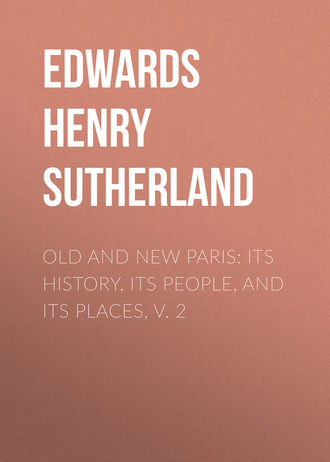 полная версия
полная версияOld and New Paris: Its History, Its People, and Its Places, v. 2
The street cobblers of Paris have frequently given heroic instances of devotion and patriotism. During the massacre of St. Bartholomew they saved many Protestants from the edge of the sword. Their little shops were divided into two compartments, of which the upper one, approached by a small ladder, served as lumber-room for a mass of leather scraps and old shoes. It was here that more than one of the companions of Admiral Coligny found safety.
Some time afterwards, defying the terrible edicts of Richelieu, a Paris cobbler transmitted some vitally important correspondence to the prisoners in the Bastille, by cleverly sewing the letters between the soles of shoes. Later on his shop became a sort of literary rendezvous. Politics were indeed talked there; but it was the latest prose and the latest verse which chiefly occupied the frequenters. The cobbler was at that period accustomed to combine with his leathern functions those of “public-writer.”
French authors and poets have always had a kindness for the cobbler. François Villon wrote what is considered the best of his odes in honour of the “Povres Housseurs,” makers, that is to say, of a species of boots worn in the fifteenth century. It is known that the great Corneille did not think it beneath his dignity to make an intimate friend of the cobbler of the Rue d’Argenteuil.
The free atmosphere which surrounded his wooden shop apparently inspired the artist in leather with a passion for joyous rhymes and a love of literary works, together with a certain fund of satire which attracted men of letters towards him.
The most celebrated Paris cobbler of the eighteenth century was Henry Sellier, whose shop stood in the Rue Quoquereau, to-day the Rue Coq-Héron. This shop was a vile hut of rotten planks, the roof of which, a piece of oil-cloth held up by a couple of broom-handles, was riddled like a sieve. Nevertheless, the proprietor wrote spirited verse, and the success of his poems was such that Louis XIV. received a copy of them, together with their author, in his château at Fontainebleau. The effusions of Sellier, moreover, gained the approbation of Fontenelle, whose good opinion brought them greatly into fashion, and even excited the jealousy of contemporary poetasters. One of Sellier’s critics published a couplet charging him with being assisted by famous collaborators; to which the cobbler, who, whether poet or not, was always ready with a repartee, penned in reply another couplet to the effect that the absence of wit and every other quality from the verses of his accuser sufficiently proved that he, at least, wrote everything himself.
In 1789 the cobbler’s shop promptly and proudly bore aloft the tricolour cockade; it became a rendezvous for patriots, and a political cabinet in which more than one great popular resolution was passed. When the legislative assembly had declared that the country was “in danger,” all the young shoemakers hastened to enlist; the paternal artists in leather offered their children to France. In those battalions of volunteers which were sometimes disdainfully described as an army of “vagabonds, tailors and cobblers,” the last-named contingent, a numerous one, fought heroically enough.
Under the Restoration the hut of the cobbler was a political and secret rendezvous for the Bonapartists and the Republicans. Much whispering and much writing went on there; many a song, penned by a literary cobbler, issued thence in manuscript, to travel rapidly from workshop to workshop and inflame the political sentiments of partisans. After 1830 the cobbler openly showed his disapprobation of the citizen royalty. The interior of his shop was completely papered with political caricatures; one manuscript satire or cartoon, torn down by the police to-day, was succeeded by another to-morrow. The police, however, were so vigilant that the cobbler at length found it advantageous not to meddle too much with politics, and developed a tendency for frequenting cheap taverns, in which his songs and conversation procured him a satisfactory measure of admiration. He did not become a drunkard, but he sought inspiration in moderate potations. A celebrated advocate had lived for sixteen years in the Rue Coq-Héron, and just beneath the walls of his mansion a cobbler had long been accustomed to hammer at the soles of shoes. A provincial visitor one day asked this cobbler whether he knew the advocate in question. “No, sir,” was the imperturbable reply. The advocate overhead was told of it, and, mystified at such an instance of ignorance, came down to reproach his humble neighbour. “You do not know me?” he said, “and yet we have lived sixteen years side by side!” “Just so,” answered the cobbler, without the least embarrassment; “you have been next door to me for sixteen years, and have not once asked me to drink with you.”
Among the shops and other establishments that have disappeared from Paris may be mentioned the ancient “café,” properly so-called, where coffee was served but smoking forbidden, and the “café estaminet,” where smoking was permitted. Every café is now a café estaminet; though it is the latter term, not the former, which has gone out of use. The serving of beer at cafés was of course an innovation; but the drinking of beer has become so general in Paris that there are now numbers of so-called “brasseries” (literally “breweries,” which these places are not), where beer is the principal if not the only beverage served. In a history of cafés the introduction of music and the development of the café concert – the French music-hall – would have to be noted. Of late years, too, music of a certain kind – especially the music of the Hungarian gipsies – executed by members of the gipsy race more or less authentic, has been introduced into restaurants.
CHAPTER XL.
THE PARIS PRESS
French Governments and the Press – The Press under Napoleon – Some Account of the Leading Paris Papers – The FigaroUNDER the ancient Monarchy journalism could scarcely be said to exist in France, and the censorship exercised over books was so severe that all political works of a critical character written by Frenchmen had to be published in Holland or in England. Arthur Young saw in the absence of newspapers one of the causes of the panic which seized whole classes and entire neighbourhoods on the outbreak of the Revolution. Absurd rumours were put into circulation, and there were no journals by which to test their accuracy; for if the press is sometimes a purveyor of gossip, it is above all a corrector of false intelligence. A decree of the year 1728, to go back no further, punished by branding, the pillory and the gallows, those who printed, composed, or distributed “works considered criminal.” Some years afterwards the parliament of Paris, which at this time was exposed to many attacks, adopted a declaration which condemned to hanging anyone who penned or printed writings which tended to assail religion, to disturb men’s minds, to undermine the authority of the king, or to trouble the order and tranquillity of his dominions. No great use was made of this law, for the Bastille sufficed to silence those who spoke too loudly; but it was always agreeable to know that, if necessary, objectionable writers could have their pens snatched from them for ever.
The Revolution overthrew that majestic edifice in which France had so long slumbered in peace. The Constitution of 1791 set forth that, “the free communication of thoughts and opinions is one of the most precious of men’s rights.” It provided that every citizen should be free to “speak, write, print, without his writings being liable to inspection or censorship before publication.”
This uncurbed liberty, however, was necessarily of short duration. In the famous Constitution of 1793, which was never put in force, the Convention guaranteed to every Frenchman “liberty of the press,” a maxim which always looks well as a decoration on the frontispiece of the Constitutional Temple; but the decree of the 29th of March, 1793, modified this excessive licence by a little article couched in these terms: – “Anyone who shall have composed or printed writings which aim at the dissolution of the national representation, and the re-establishment of royalty or any other power which arrogates the sovereignty of the people, shall be arraigned before the tribunal extraordinary and punished with death.” The Convention did not reconstruct the Bastille; but it sent a number of journalists to the guillotine by way of warning to their fellows. The warning, however, was lost on Frenchmen, who, with their natural characteristics, preferred to forfeit their head rather than their tongue, and died jesting at the executioner.
The Directory followed the example of the Convention. The Constitution of the year III. declares, in article 353, that “no one can be prevented from saying, writing, printing, or publishing his thoughts,” but a law of the 27th Germinal, in year IV., added the following clause: “All those shall be punished with death who by their speeches, or their printed writings, whether circulated or placarded, provoke the dissolution of the National Assembly or that of the Executive Directory … or the re-establishment of royalty, that of the Constitution of 1793, that of the Constitution of 1791, or of any other government, save the one established by the Constitution of 1791, accepted by the French people, etc.” With this important exception the law is clement enough; nor, indeed, were the authorities anxious to enforce the death clause where a milder punishment would serve the turn. The Directory, after the 18th Fructidor, instead of shooting ill-behaved journalists, contented itself with sending out forty-five of them to colonise Sinnamary, at the same time placing the journals under the supervision of the police, who could summarily suppress them. The Directory, moreover, acting perhaps on the principle of equality before the law, imposed a stamp-duty on all journals, so that Thought, like other commodities, began to contribute its share to the State by which it was protected.
With the Consulate, France, as regarded press matters, went straight back to the time of Louis XIV. The first article of a consular decree, issued January 17th, 1800, disposed of journalism once and, if not for ever, at least for a considerable time. It sets forth that the minister of justice shall, so long as the war lasts, allow no more than thirteen political journals, each of which is specified by name, to be published at Paris. The fifth article of this decree provided for the instant suppression of all newspapers inserting articles which might be wanting in “the respect due to the social compact and the sovereignty of the people, or to the glory of the French armies,” or which might print “invectives against the governments and the nations allied to or in friendly relations with the Republic, even though these articles were extracted from foreign periodicals.” Nor did Napoleon’s vigilance cease with this. He despised newspapers, but was afraid of books. Accordingly, while the censorship was re-established for journals, printing and publishing offices were made monopolies, and placed under surveillance as in the best days of the old Monarchy. It was for the master to think, to will, to act for all his subjects; he wished France and all Europe to be occupied with him alone. The police took care that there should be silence around him, and human thought was represented by the voice of the cannon. On the fall of Napoleon a charter was given to France by the restored Monarchy, in which the French were declared to possess the right of publishing and printing their opinions conformably to the laws intended to repress the abuse of this liberty. But the very first bill introduced into the new assembly subjected pamphlets to the censorship, and newspapers to the authorisation of the crown, while printers were required to take out licences, which would only be continued on good behaviour.
In 1815, during the Hundred Days, the emperor established the liberty of the press, and the second Restoration maintained this concession. Only for a time, however; on the assassination of the Duc de Berry, someone discovered that “the real dagger which had stabbed the duke” was a liberal idea; and a law was passed by which a Government authorisation was required before starting a newspaper. The censorship was at the same time re-established, while police courts were empowered to suspend and suppress newspapers on the ground of evil tendencies. Finally, the notorious “ordonnances” of 1830 suppressed liberty of the press altogether. This led to the Revolution of July, and the charter accepted by Louis Philippe on his accession to the throne declared that the censorship was not only abolished but could never be re-established. But the newspaper stamp was maintained, and no one could start a journal without previously depositing a large sum as caution-money, with which to pay damages in case of libel.
After the Revolution of 1848 liberty of the press was once more proclaimed, and it seemed as though France might at last accustom itself to free newspapers, even as Mithridates accustomed himself to poison. Then, however, in 1851, came the Coup d’état, and once more the press was fettered. A system of “warnings” and of “communiqués” was now adopted. The communiqué was a notice addressed to the journal by the Government, which the editor of the journal was obliged to insert. The warnings were of two kinds – first and second; a first warning, administered at will by the authorities, had no immediate effect; but after a second warning, the journal receiving it could be at once suppressed. “This ingenious system was so much admired that it was forthwith adopted,” says M. Laboulaye in an article on the subject, “by the four great states which march at the head of modern civilisation: Spain, Turkey, Austria and Russia.” It was necessary, moreover, under the Second Empire to obtain, before publishing a new journal, an authorisation from the Government. The first newspaper established in France was the Gazette de France, founded by the physician of Louis XIII. in 1631; the most widely known and the most highly esteemed being the Journal des Débats, founded by the Bertin brothers in 1789, the great revolutionary year in which also the official organ under all systems of government, Le Moniteur Universel, was started.
Among the contributors to the Journal des Débats may be mentioned: Michel Chevalier, Saint-Marc Girardin, John Lemoinne, Prévost Paradol, Renan, and Taine; the dramatic criticisms of the journal were for many years written by Jules Janin, and the musical criticisms by Berlioz.
The Constitutionnel was founded at the time of the Restoration in 1815. The most celebrated of its editors was Dr. Véron, for some years manager of the Opera, in which character he produced Meyerbeer’s Robert le Diable. The most famous of the contributors to this journal was Sainte-Beuve, who for a long succession of years published in it every Monday one of those literary articles which, in their collected form, are known throughout the civilised world as “Causeries du Lundi.” Before contributing the “Causeries” to the Constitutionnel (they were continued and concluded in the Moniteur), Sainte-Beuve had published, under the title of “Portraits,” a long series of biographical and critical articles in the Revue de Paris, which, after the cessation of that periodical, he went on with in the Revue des deux Mondes. M. Nestor Roqueplan, who, like Dr. Véron, was for some time manager of the Opera, contributed dramatic criticisms for many years to the Constitutionnel, and no more brilliant articles of the kind were ever penned. The musical critic was at this time the notorious P. A. Fiorentino, who afterwards joined the staff of the Moniteur.
La Presse was founded in 1836 by Émile de Girardin, and it must always be remembered as the first cheap journal started in France, and indeed in all Europe. Paris has now newspapers at two sous and even one sou; but in 1836 a journal at three sous, the price at which La Presse was issued, seemed a marvel; and M. de Girardin’s enemies of the established journals hinted in no doubtful terms that his journal at three sous could only exist through the aid of a Government subvention. It has been related elsewhere how an innuendo to this effect from Armand Carrel led to a duel in which Carrel, while inflicting a serious wound on M. de Girardin, was himself shot dead. Many years later than 1836, when La Presse was started, the invariable price of a London morning newspaper was fivepence; there was a penny stamp on each number issued, and an impost of eighteenpence on each advertisement. The cheap press has only been rendered possible in England by the removal of the newspaper-stamp, the advertisement-stamp, and finally the duty on paper.
From 1836 to 1856 La Presse was edited by M. de Girardin; his successor was M. Nefftzer, who afterwards founded that excellent paper Le Temps. La Presse then passed beneath the direction of M. Guéroult, who left it to found L’Opinion Nationale; and afterwards of M. Peyrat and others. The dramatic, and musical, and artistic feuilleton of La Presse was originally in the hands of the incomparable Théophile Gautier, whose collected articles are as remarkable for searching and subtle criticism as for brilliant description. He was succeeded by Paul de Saint-Victor, whose contributions were scarcely inferior to those of his distinguished predecessor. Paul de Saint-Victor is far less generally known in England than Théophile Gautier. A good idea of his remarkable talent may be formed from his volume on tragedy and comedy, “Les deux Masques.”
When in 1852 it was determined to improve as much as possible the official organ of the newly established Empire, as of previous Governments in France, a number of the most popular writers were tempted to the Moniteur by offers of increased pay. Théophile Gautier quitted the Presse for the official journal, and P. A. Fiorentino, without quitting the Constitutionnel, wrote musical criticisms for it under a nom de plume which concealed his identity from no one interested in journalism. This last-named journalist, Italian by nationality, was by no means an honour to the French press; he was more than suspected of taking bribes, and when the Society of Men of Letters instituted an inquiry into his conduct, he attacked the secretary of the society so violently in the paper called Le Corsaire, that a challenge and a duel ensued. Amédée Achard was run through the body, and Fiorentino passed some weeks in prison. Achard did not die, nor did Fiorentino lose his position on the press. The accusation made against him by the Society of Men of Letters was that he acted at once as musical critic and musical agent; and it might fairly be presumed that singers on whose salaries he received a commission were more carefully looked after and more warmly praised than those who did not employ his services. He is said to have attempted to justify himself to some of his friends by representing himself as the “Artists’ advocate” – “L’avocat des artistes;” though his true function, the one which he was understood by the editor of his newspaper and by his readers to have undertaken, was that of critic or judge. To the accusations brought against him by the Society of Men of Letters he replied, however, by a simple denial; and the object of the duel he had sought with Amédée Achard was evidently to prevent such accusations from being brought against him in the future.
Another journal, started under the Empire with imperial support, and with M. Granier de Cassagnac, father of the well-known writer, deputy and duellist of the same name, as editor, called Le Pays, was well and daringly written, but found no favour with the public. Neither, as a matter of fact, did the Moniteur, notwithstanding the brilliancy of the writers attracted to its columns from other journals.
L’Opinion Nationale first appeared in 1859, at the time of the war for the liberation of Italy. The unity of Italy and the independence of Poland were for many years its watchwords; and during the Polish insurrection of 1863, as also during the long agitation that preceded it, this journal was the recognised organ of oppressed nationalities. By English readers interested in theatrical matters, L’Opinion Nationale will be remembered as the journal in which M. Sarcey, the well-known critic, made his literary début. M. Sarcey possesses, as a writer, neither the ingenuity and charm of Jules Janin, nor the dazzling style of Théophile Gautier, or of Paul de Saint-Victor, nor the delicate observation of Nestor Roqueplan; but he is inspired, more perhaps than any other critic, by taste, love, passion for the stage.
Le Monde was started under that name in 1860 as a substitute for L’Univers, which, placing the Pope before the Emperor and preferring Rome to Paris, had got itself into trouble with the Government. It was edited for many years by M. Louis Veuillot, most vigorous of Ultramontane journalists, and author of several remarkable books, including “Les Odeurs de Paris,” “Les Parfums de Rome,” and a curious study of feudal rights and privileges, as, according to M. Veuillot, they really existed in France before the Revolution.
Le Temps, one of the best of the Paris papers, after having been discontinued for some years, was revived in 1861 by M. Nefftzer, previously editor of La Presse. Le Temps soon took rank as what the French call a serious journal. For many years one of the most interesting features of Le Temps was the letter on English affairs contributed from London by M. Louis Blanc. Among the other distinguished contributors to Le Temps may be mentioned M. Scherer, the literary critic, and M. Louis Ulbach, chiefly known as a novelist, but who for many years wrote for this journal its theatrical feuilleton. There are plenty of papers published in Paris besides those we have mentioned, some of them in the enjoyment of large circulations, but distinguished by no marked features, or by none that possess special interest for English readers. The best-known, however, of all the Paris journals is the Figaro, published originally under the Restoration, and edited for some time by Nestor Roqueplan. After numerous prosecutions, it ceased to exist; suppressed practically if not formally by the Government.
But in 1854 the Figaro (which, it need scarcely be said, derived its name from the celebrated barber invented by Beaumarchais) was revived by Mme. Villemessant, and it played an important part, though by no means a consistent one, under the Second Empire. This it still continues to do; and whatever its political views may be, it is the most amusing, the most interesting, and one may almost say, the most literary journal in Europe. Among the celebrated writers who have from time to time contributed to its columns may be mentioned Edmond About, Théodore de Banville, Henri Rochefort, B. Jouvin, Albert Wolff, and Henri de Pène, who, for criticising the manners of French subalterns, found himself exposed to the necessity of fighting all the lieutenants and sub-lieutenants of the French army, a task from which he was saved by being almost mortally wounded by the first of his antagonists. The cause of M. de Pène’s encounter with the junior officers of the French army, as represented by the clever swordsman who ran him through the lungs, was an article, written by the contributor to the Figaro, on a ball given at the École Militaire. The youthful officers were, he declared, too constant and too eager in their attendance at the buffet; and he added that when one of them had a plate of cakes offered to him by a waiter, he said he was not sure that he could eat them all, but that he would accept them nevertheless. The jest was an ancient one, but it angered the young bloods of the Military School, and their indignation demanded a victim, who at once offered himself in the person of the author of the injurious statement.
The case of Henri de Pène and of so many other fighting journalists, with the redoubtable Henri Rochefort and Paul de Cassagnac among them, suggests that in France a newspaper-writer should be as much a master of the sword as of the pen. This does not interfere with the fact that one of the most gentle and amiable of modern French writers, M. Ernest Legouvé, possessed the reputation of being the first fencer of his day.





